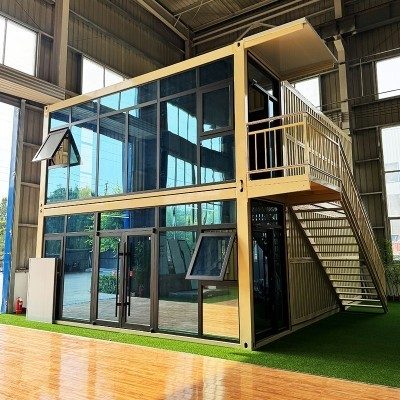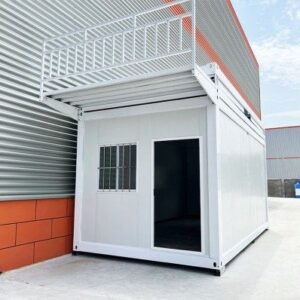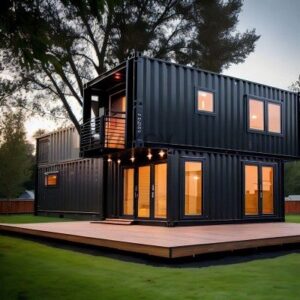If you’re curious about how to build container house, you’re in the right place. Container homes are reshaping affordable, sustainable living with their speed and versatility. Whether you’re a DIY enthusiast or just starting out, this guide breaks down everything you need—from choosing the right shipping container to finishing touches—so you can confidently bring your dream home to life. Ready to discover the step-by-step process and expert tips? Let get started!
Container Houses What is a Container House
A container house is a type of home built using standard shipping containers as the main structural element. These containers, originally designed for cargo transport, are repurposed into livable spaces by modifying their interiors and exteriors. Shipping container home construction offers a modular, durable, and cost-effective alternative to traditional building methods.
Types of Shipping Containers Used for Container Houses
Most container homes use two popular sizes of containers:
- 20-foot containers – About 160 square feet of space, easier to transport and fit into smaller lots.
- 40-foot containers – Double the size (around 320 square feet), better for larger rooms and open layouts.
- 40-foot High Cube containers – Same length as 40-foot containers but about one foot taller, offering extra headroom.
Containers are made of COR-TEN steel, designed to resist rust and harsh weather during shipping. The most common types used for homes include standard dry containers and sometimes insulated or refrigerated containers, depending on insulation needs.
Advantages and Disadvantages of Container Homes
Container houses come with several advantages that make them appealing:
- Durability and strength – Built to withstand rough seas, containers are structurally solid.
- Speed of construction – Prefabricated containers can cut down build times significantly.
- Cost savings – Often more affordable than conventional homes when considering materials and labor.
- Eco-friendly – Reusing containers promotes recycling and reduces waste.
- Portability – Can be moved or relocated if necessary.
However, there are also challenges to consider:
- Insulation complexity – Metal walls can lead to heat loss or gain; proper insulation is essential.
- Space limitations – Containers have fixed dimensions, which can restrict design flexibility.
- Permitting difficulties – Some areas have strict building codes or zoning rules that may limit container house approval.
- Modification costs – Cutting and reinforcing containers for windows, doors, and utilities can add to expenses.
Common Myths and Facts About Container Homes
There’s some confusion around container homes that can affect decision-making. Here are a few common myths and the facts behind them:
- Myth Container homes are unsafe or flimsy
Fact Containers are made from strong steel designed to carry heavy loads and resist natural challenges. - Myth Container homes look like boxes and are unattractive
Fact With proper design, containers can be transformed into stylish, modern, and comfortable homes. - Myth Container houses are not energy efficient
Fact When insulated correctly using spray foam, panels, or vapor barriers, container houses can be very energy efficient. - Myth It’s cheaper to just build a traditional home
Fact While initial container cost might be cheaper, modifications and compliance with codes can bring up costs; however, overall they still offer good value and speed.
By understanding what container houses really are, the types of containers used, and the real advantages and challenges, you can make an informed choice about whether this innovative construction option fits your needs.
Planning Your Container House
Choosing the Right Container Size and Type
When planning to build a container house, selecting the right shipping container is crucial. The most common sizes are 20-foot and 40-foot containers, with 40-foot High Cube containers offering an extra foot of height inside. This additional height gives more headroom and flexibility for insulation and interior design.
- 20ft containers are easier to move and great for smaller homes or modular setups.
- 40ft containers provide more space for larger layouts or open floor plans.
- High Cube containers (usually 9.5 ft tall) are popular for residential builds due to extra vertical space.
Consider your living needs and site access when choosing size—multiple containers can be combined for bigger homes, while single container units work well for tiny homes or guest houses.
Designing Your Container House Layout
Decide early if you want a single container design or a modular home using multiple containers. Each approach affects the budget, complexity, and space:
- Single container homes are simpler and quicker to build but limited in space.
- Multiple containers stacked or placed side-by-side allow creative layouts but require more planning and structural work like welding and reinforcing.
Plan your interior layout with these in mind:
- Room placement and size
- Natural light through window openings
- HVAC system locations
- Plumbing and electrical runs
Budgeting and Cost Estimates
Budgeting is a big part of container home planning. Here’s what to factor in:
- Cost of containers: Prices vary depending on condition, type, size, and seller.
- Site work and foundation: Land prep, leveling, and suitable foundation choice.
- Container modifications: Cutting openings, welding, insulation, and weatherproofing.
- Interior finishes: Plumbing, electrical, HVAC, flooring, and walls.
- Permits and inspections
Typical total costs can range widely but expect to spend between $30,000 to $100,000+, depending on size and finish quality.
Finding and Purchasing Containers Locally or Online
You can buy shipping containers through:
- Local sellers or scrapyards: Often quicker and easier for inspection and transport.
- Online container marketplaces: Broader selection and sometimes better prices but account for shipping costs.
- Container dealers specializing in housing-grade units: These often come with fewer dents or rust and may be better suited for homes.
Tips to ensure value:
- Inspect containers in person if possible.
- Check for structural damage, rust, and previous use.
- Confirm size and type (High Cube vs standard).
- Factor transportation costs into your budget.
Choosing the right container and planning the layout carefully upfront will set a smooth path for shipping container home construction and help ensure your project stays on budget and on time.
Preparing for Construction of Container House Permits and Site Work
Before you start building your container house, getting the right permits and understanding local building codes is essential. Rules vary widely across the U.S., so check with your city or county building department early. You’ll likely need:
- Building permits specific to container or modular homes
- Zoning approvals covering land use and structure types
- Inspections during key stages like foundation and electrical work
Ignoring permits can lead to fines or even having to tear down your project, so don’t skip this step.
Site Selection and Land Preparation
Choosing the right location for your container home plays a big role in construction ease and living comfort. Consider:
- Soil type and drainage—avoid flood-prone or unstable ground
- Access to utilities like water, electricity, and sewage
- Orientation for sunlight and wind, which impacts energy efficiency
Once the site is chosen, prepare the land by:
- Clearing debris and leveling the ground for a solid foundation
- Marking boundaries accurately with a surveyor’s help
- Installing access paths for heavy equipment and containers
Tools and Materials Checklist
Having the right tools and materials ready speeds up your build and reduces setbacks. Common essentials include:
- Cutting tools for modifications (plasma cutter, grinders)
- Welding equipment for joining container sections securely
- Insulation materials such as spray foam or rigid panels
- Electrical and plumbing supplies adapted for metal structure installation
- Safety gear like gloves, eye protection, and helmets
Safety Considerations During Construction
Working with steel containers means heavy lifting and metal cutting, so safety is non-negotiable. Keep these in mind:
- Always wear personal protective equipment (PPE) including gloves, goggles, respirators
- Be cautious with welding and cutting tools to avoid burns or fires
- Use proper lifting equipment and support when moving containers onsite
- Follow OSHA and local job site safety regulations strictly
Doing the prep work thoroughly sets a strong foundation for building a durable, comfortable container home that fits within local rules and keeps everyone safe.
Step-by-Step Building Process for Container Homes
Building a container home takes careful planning and execution. Here’s a clear breakdown of the key stages, from foundation to finishing touches, so you can understand what goes into shipping container home construction.
Foundation Setup for Container Houses
A solid foundation is critical for stability and longevity. Popular foundation types for container homes include:
- Concrete Slab: A flat, durable base ideal for most soil types.
- Pier Foundation: Concrete piers keep containers raised, good for uneven ground or flood-prone areas.
- Strip Footings: Continuous strips of concrete under load-bearing walls, providing strong support.
Steps for foundation preparation:
- Level the ground precisely to avoid shifting.
- Pour concrete or install piers according to your chosen foundation type.
- Allow enough curing time before placement of containers.
Container Modification Process
Before assembling, containers need specific modifications to make them livable:
- Cutting Openings: Create windows, doors, and vents by cutting container walls using plasma cutters or saws.
- Welding: Re-attach reinforcement frames around openings for structural safety.
- Insulation and Weatherproofing: Proper insulation is crucial—options include spray foam panels and rigid foam boards paired with vapor barriers to block moisture.
- Structural Reinforcements: Depending on the design, you might need to strengthen the container using steel beams or braces.
Assembly and Onsite Construction
Once modified, containers are moved to the site and set in place.
- Transport and Positioning: Use cranes or forklifts to stack and align containers.
- Joining Containers: Weld or bolt containers together securely to create rigid connections.
- Sealing: Apply waterproof sealants along all joints to prevent leaks.
- Roofing and Drainage: Install a roofing system that includes gutters and downspouts to direct water away from the home.
Interior Work
The inside of your container home needs several components to make it comfortable and functional:
- Electrical Wiring and Plumbing: Run wiring and pipes before finishing walls, following local building codes.
- HVAC Systems: Container homes need good heating and cooling; mini-splits or ductless HVAC units work well.
- Interior Finishes: Add drywall or paneling for walls, install flooring (like laminate or hardwood), and fit cabinets and fixtures.

Exterior Finishing and Landscaping
Finishing touches outside improve durability and curb appeal:
- Painting and Corrosion Protection: Use high-quality exterior paint with rust inhibitors to prevent container corrosion.
- Landscaping: Plan outdoor spaces with paths, gardens, or patios to complement your container home.
This step-by-step approach ensures your container home is strong, weather-resistant, and comfortable, meeting the unique needs of container house design and construction.
Key Considerations for Building a Container House
When planning your shipping container home construction, there are important factors to keep in mind. From environmental impact to energy efficiency and overcoming common challenges, these key considerations help ensure a successful build and long-lasting, sustainable living.
Environmental Impact and Sustainability Tips
Building a container house naturally leans toward sustainable living since it reuses shipping containers that might otherwise go to waste. Here’s how you can further enhance sustainability:
- Choose recycled or refurbished containers to reduce environmental footprint.
- Use eco-friendly insulation methods like spray foam or sheep’s wool to improve energy savings.
- Opt for low-VOC paints and finishes to minimize harmful emissions.
- Incorporate solar panels or other renewable energy sources.
- Design for rainwater collection and use water-saving fixtures to conserve resources.
- Plan landscaping with native plants to reduce water needs and support local ecosystems.
These steps improve your container home’s green credentials while also helping lower ongoing costs.
Energy Efficiency Solutions for Container Homes
Container homes can be prone to heat gain and loss because of steel’s high conductivity, so prioritizing energy efficiency is vital:
- Proper insulation is key, with options including spray foam, rigid panels, or insulated blankets.
- Add vapor barriers to prevent moisture buildup inside walls.
- Install energy-efficient windows and doors designed to minimize heat transfer.
- Incorporate passive cooling and heating strategies, like shading, cross ventilation, and thermal mass.
- Use LED lighting and Energy Star-rated appliances to cut power usage.
- Consider installing smart thermostats and efficient HVAC systems tailored for container home layouts.
Good energy practices keep your home comfortable year-round and reduce utility bills.
Common Challenges and Troubleshooting Tips
Building a container house isn’t without challenges. Knowing these upfront helps you prepare better:
- Condensation and moisture: Without proper insulation and vapor barriers, steel walls can lead to dampness and rust. Always seal and ventilate well.
- Permitting and zoning issues: Many local regulations aren’t familiar with container homes. Check and secure building permits early to avoid delays.
- Structural modifications: Cutting openings for windows and doors weakens the steel frame. Reinforce these spots with proper welding and bracing.
- Transport and crane logistics: Moving and stacking large containers needs professional help and equipment – plan accordingly.
- Thermal bridging: Steel transfers heat quickly, causing cold spots—good insulation and breaking thermal paths help combat this.
- Interior space limitations: Container homes have tight widths, so maximize storage and layout efficiency when designing interiors.
By anticipating these issues, you can troubleshoot smoothly and ensure your container home stands strong, looks great, and functions well over time.
Cost Breakdown and Budgeting Tips for Building a Container House
Building a container house involves several stages, each with its own costs. Understanding these typical expenses can help you plan your budget effectively and keep your project on track without sacrificing quality.
Typical Costs at Each Stage of Container Home Construction
1. Container Purchase
- Cost range: $2,000 to $5,000 per container depending on size and condition.
- Used 20ft and 40ft high cube containers are the most common choices.
- Prices vary by location; buying locally can save on transport fees.
2. Site Preparation and Foundation
- Ground leveling, excavation, and foundation pouring typically cost between $5,000 and $15,000.
- Foundation type matters—concrete slab foundations are common and durable but may be pricier than pier foundations.
3. Container Modification
- Cutting openings for windows and doors, welding, and reinforcements can range from $10,000 to $25,000, depending on complexity.
- Insulation and weatherproofing (spray foam or rigid panels) add $3,000 to $7,000.
- Materials and labor fluctuate based on local rates.
4. Assembly and Installation
- Moving and stacking containers on-site, welding containers together, and installing roofing and drainage systems can cost $8,000 to $20,000.
- Larger or multi-container builds are more expensive.
5. Interior Work
- Electrical wiring, plumbing, HVAC installation, wall finishes, flooring, and fixtures run between $15,000 and $35,000.
- Energy-efficient systems may increase upfront costs but save long term.
6. Exterior Finishing and Landscaping
- Painting, corrosion protection, and outdoor features vary widely but expect $5,000 to $12,000.
How to Save Money Without Compromising Quality
- Buy containers locally to reduce shipping fees.
- Keep your design simple, using fewer containers or a straightforward layout.
- Do some work yourself if you have skills—like painting or basic interior finishing.
- Plan for energy efficiency upfront to save on future utility bills.
- Shop around for contractors and materials to get competitive pricing.
- Use prefab elements where possible to cut down labor time.
- Focus on durable materials to reduce maintenance costs later.
- Apply for building permits early to avoid fines and delays that increase costs.
Budgeting carefully means balancing upfront expenses with long-term benefits, so putting in the research now can pay off throughout the life of your container home.
Examples of Container Houses Real Life Cases and Inspiration
Seeing real container house projects can really help you understand what’s possible with shipping container home construction. Homeowners and companies across the U.S. have created amazing spaces by using modular container homes, proving flexibility in design, budget, and location.
Homeowner Built Container Houses
Many DIY builders have transformed old containers into cozy, affordable homes. For instance:
- Single Container Studio Homes: Simple 20ft containers converted into stylish tiny homes, perfect for singles or couples who want minimalist living with smart interior design.
- Multi-Container Family Homes: Some families have joined multiple 40ft or 40ft High Cube containers to form spacious two- or three-bedroom homes with open floor plans and modern finishes.
- Off-Grid Sustainable Homes: Owners use eco-friendly insulation, solar panels, and rainwater collection systems to create sustainable container homes that cut utility costs.
Company Designed Container Homes
Several companies specialize in prefabricated or custom-built container houses with professional design and rapid construction:
- Prefab Modular Homes: Delivered as pre-modified units, these container homes reduce build time significantly. Builders install HVAC, plumbing, and electrical systems beforehand, making onsite assembly quick.
- Luxury Container Homes: Some companies combine shipping containers with traditional materials to deliver high-end homes featuring large windows, advanced insulation, and smart home tech.
- Commercial Container Spaces: Beyond homes, containers have been adapted for offices, pop-up shops, and community centers, showcasing how versatile container design ideas can be.
Inspiration Gallery Highlights
- Urban Tiny Home: A single 20ft container fitted with foldable furniture and energy-efficient appliances, maximizing small city lots.
- Beachside Retreat: Combining three 40ft containers with large glass walls offers panoramic views and natural light.
- Mountain Cabin: A container home modified with rustic wood interiors and off-grid solar power, perfect for remote locations.
Why These Examples Matter
- They illustrate how container homes suit different budgets, climates, and lifestyles.
- They show the range from simple DIY projects to professionally engineered homes.
- They prove container home foundation types and modification techniques can adapt containers for comfortable living anywhere.
If you’re considering building a container house, these real-world examples offer practical insights that typical plans or guides don’t cover. From cost-effective DIY builds to premium prefab options, container homes are becoming a popular, sustainable housing choice in the U.S. market.
Frequently Asked Questions about How To Build Container House
How long does it take to build a container house
The time to build a container house varies depending on the design complexity, site conditions, and whether you’re doing it yourself or hiring pros. On average:
- Simple single-container homes can take 3 to 6 months.
- Multiple container designs or custom layouts may take 6 to 12 months.
- Prefab or modular container homes generally come together faster, sometimes within a few weeks once materials are on-site.
Keep in mind that getting permits and site prep often adds time before actual construction begins.
Do container homes withstand all weather conditions
Container homes are designed from tough steel meant to handle harsh environments during shipping, so they’re naturally strong and weather-resistant. However, to withstand all weather you’ll need:
- Proper insulation and vapor barriers to handle temperature swings.
- Durable weatherproofing and corrosion protection coatings on the exterior.
- Well-planned roof drainage to avoid water pooling.
- Structural reinforcements where needed, especially in hurricane- or earthquake-prone areas.
If built and maintained properly, container houses can be very durable across various climates in the U.S.
Can container houses be expanded later on
Yes, one of the benefits of container house construction is flexibility:
- Containers can be added side-by-side or stacked vertically.
- You can modify interiors or combine multiple containers to increase living space.
- Expansions usually require new permits and potential foundation work, so plan for these when budgeting.
This modular nature means container homes are great for people who may want to grow their home over time.
What maintenance is required after building a container home
Container homes need some ongoing maintenance to protect and preserve them:
- Inspect for rust or corrosion annually, especially in humid regions.
- Maintain exterior paint or sealants to guard against weather damage.
- Check and repair roof drainage systems to prevent leaks.
- Maintain HVAC, plumbing, and electrical systems like a traditional home.
- Keep an eye on insulation integrity and replace or repair if you notice drafts or moisture.
Regular care keeps container homes comfortable and extends their lifespan well beyond standard housing



